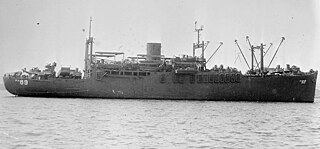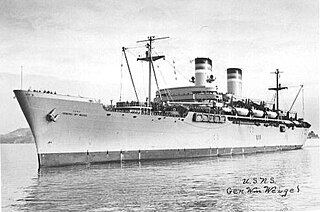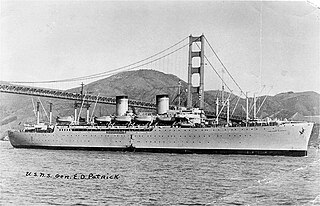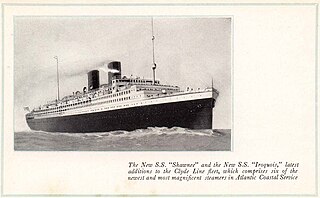
USS General J. H. McRae (AP-149) was a General G. O. Squier-class transport ship built for the United States Maritime Commission during World War II. In 1946 she was transferred to the US Army and operated as USAT General J. H. McRae. On 1 March 1950 she was transferred to Military Sea Transportation Service and operated as USNS General J. H. McRae (T-AP-149). She was named for US Army Major General James H. McRae.

USS Admiral Hugh Rodman (AP-126) was an Admiral W. S. Benson-class transport: Laid down, 24 April 1944, as a Maritime Commission type (P2-SE2-R1) hull, under Maritime Commission contract,, at Bethlehem Shipbuilding Corporation, Alameda, California; launched on 25 February 1945; commissioned as the USS Admiral Hugh Rodman (AP-126), 7 July 1945, decommissioned on 14 May 1946, at New York; transferred to the U.S. Army Transportation Service in May 1946; commissioned USAT General Maurice Rose on 1 August 1946; reacquired by the U.S. Navy and assigned to the Military Sea Transport Service (MSTS); placed in service as USNS General Maurice Rose (T-AP-126) on 1 March 1950.

USS General Stuart Heintzelman (AP-159) was a General G. O. Squier-class transport ship for the U.S. Navy in World War II. She was named in honor of U.S. Army general Stuart Heintzelman. She was transferred to the U.S. Army as USAT General Stuart Heintzelman in 1946. On 1 March 1950 she was transferred to the Military Sea Transportation Service (MSTS) as USNS General Stuart Heintzelman (T-AP-159). She was later sold for commercial operation before being scrapped in 1984.

USS General C. C. Ballou (AP-157) was a General G. O. Squier-class transport ship for the U.S. Navy in World War II. She was named in honor of U.S. Army general Charles Clarendon Ballou. She was transferred to the U.S. Army as USAT General C. C. Ballou in 1946. On 1 March 1950, she was transferred to the Military Sea Transportation Service (MSTS) as USNS General C. C. Ballou (T-AP-157). She was later sold for commercial operation under several names before being scrapped some time after 1981.

USS General A. W. Brewster (AP-155) was a General G. O. Squier-class transport ship for the U.S. Navy in World War II. The ship was crewed by the U.S. Coast Guard throughout the war. She was named in honor of U.S. Army general Andre Walker Brewster. She was transferred to the U.S. Army as USAT General A. W. Brewster in 1946. On 1 March 1950 she was transferred to the Military Sea Transportation Service (MSTS) as USNS General A. W. Brewster (T-AP-155). She was later sold for commercial operation under the name SS Philadelphia, before being scrapped some time after November 1987.

USS General S. D. Sturgis (AP-137) was a General G. O. Squier-class transport ship for the U.S. Navy in World War II. She was named in honor of U.S. Army general Samuel Davis Sturgis. She was transferred to the U.S. Army as USAT General S. D. Sturgis in 1946. On 1 March 1950 she was transferred to the Military Sea Transportation Service (MSTS) as USNS General S. D. Sturgis (T-AP-137). She was later sold for commercial operation under the name SS Green Port, before being scrapped in 1980.

USS General C. H. Muir (AP-142) was a General G. O. Squier-class transport ship for the U.S. Navy in World War II. The ship was crewed by the U.S. Coast Guard until decommissioning. She was named in honor of U.S. Army general Charles Henry Muir. She was transferred to the U.S. Army as USAT General C. H. Muir in 1946. On 1 March 1950 she was transferred to the Military Sea Transportation Service (MSTS) as USNS General C. H. Muir (T-AP-142). She was later sold for commercial operation under the names SS Chicago and SS San Juan, and was scrapped some time after 1985.

USS General M. L. Hersey (AP-148) was a General G. O. Squier-class transport ship of the U.S. Navy in World War II. She was named in honor of U.S. Army general Mark Leslie Hersey. She was transferred to the U.S. Army as USAT General M. L. Hersey in 1946. On 1 March 1950 she was transferred to the Military Sea Transportation Service (MSTS) as USNS General M. L. Hersey (T-AP-148). She was later sold for commercial use, and operated under the names SS Pittsburgh and SS St. Louis.

USNS General H. H. Arnold (T-AGM-9) was a General G. O. Squier-class transport ship for the U.S. Navy in World War II. She was named in honor of U.S. Army general Robert Emmet Callan. She was transferred to the U.S. Army as USAT General R. E. Callan in 1946. On 28 April 1950 she was transferred to the Military Sea Transportation Service (MSTS) as USNS General R. E. Callan (T-AP-139). Placed in reserve in 1958, she was transferred to the U.S. Air Force in 1961 and renamed USAFS General H. H. Arnold in 1963, in honor of Henry H. Arnold, the first and only General of the Air Force. She was reacquired by the Navy in 1964 as USNS General H. H. Arnold (T-AGM-9). She was struck from the Naval Vessel Register on 1 March 1982.

USS Frederick Funston (APA-89) was a Frederick Funston-class attack transport that served with the US Navy during World War II. Before serving as a Navy APA, she had been the US Army transport USAT Frederick Funston. After World War II, she was returned to the Army and operated as USAT Frederick Funston. Funston was among the seventy-two ships transferred to the Navy's Military Sea Transportation Service (MSTS) in the 1 March 1950 group and placed in service as USNS Frederick Funston (T-AP-178).

USS General William Weigel (AP-119) was a troopship that served with the United States Navy in World War II. After the war, she was acquired by the US Army and became USAT General William Weigel. On the outbreak of the Korean War, she was transferred to the Military Sea Transportation Service (MSTS) and designated USNS General William Weigel (T-AP-119), a designation she retained for her later service in the Vietnam War.

USNS Fred C. Ainsworth (T-AP-181) was a troop transport that served with the United States Military Sea Transportation Service during the Korean War. Prior to her MSTS service, she served as US Army transport USAT Fred C. Ainsworth during World War II.

USNS George W. Goethals (T-AP-182) was a troop transport that served with the United States Military Sea Transportation Service (MSTS) during the 1950s. Prior to her MSTS service, she served as U.S. Army transport USAT George W. Goethals during World War II.

USNS Henry Gibbins (T-AP-183) was a troop transport that served with the United States Military Sea Transportation Service (MSTS) during the 1950s. Prior to her MSTS service, she served as US Army transport USAT Henry Gibbins during World War II. She later served with the New York Maritime Academy as TS Empire State IV and with the Massachusetts Maritime Academy as USTS Bay State.

USNS Sgt. Sylvester Antolak (AP-192/T-AP-192) was a Boulder Victory-class cargo ship that served as a United States Army Transport, and in the United States Navy's Military Sea Transportation Service, in the post-World War II period.

The Type C4-class ship were the largest cargo ships built by the United States Maritime Commission (MARCOM) during World War II. The design was originally developed for the American-Hawaiian Lines in 1941, but in late 1941 the plans were taken over by the MARCOM.

USS Admiral C. F. Hughes (AP-124) was a Admiral W. S. Benson-class transport named in honor of Charles Frederick Hughes, an admiral in the United States Navy who served as Chief of Naval Operations from 1927 to 1930. It was later renamed the ship USAT General Edwin D. Patrick after Edwin D. Patrick, an Army general who died in World War II.

USAT Sea Scamp was a Type C3 ship S-A2 troop transport that saw service in World War II.

Shawnee was a passenger steam turbine-powered ship built in 1926-1927 by Newport News Ship Building & Drydock Co. of Newport News for Clyde Steamship Company, a subsidiary of Atlantic, Gulf & West Indies Steamship Lines with intention of operating between New York and southern ports of the United States. During the World War II the liner was requisitioned by the US Government, and served as the United States Army Transport from September 1942 to March 1946 in the Atlantic, Mediterranean and Pacific. Following the end of the war, the ship was sold to a Portuguese company and renamed City of Lisbon, and subsequently resold to Yugoslavia, becoming Partizanka operating with the shipping company Jugoslavenska Linijska Plovidba until 1949 when the steamer burned while in drydock and was declared a total loss.

SS Sea Owl was a Type C3-S-A2 ship built during World War II by Ingalls Shipbuilding, Pascagoula, Mississippi. The ship was converted by Ingalls before delivery on 27 June 1944 into a troop transport for operation by the War Shipping Administration. The ship saw service in the European Theater of Operations with a final trip in January 1946 to Japan and return. The ship was released from troop service in February 1946 and placed in the James River Reserve Fleet 12 August 1946.




















